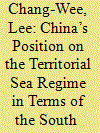| Srl | Item |
| 1 |
ID:
162450


|
|
|
|
|
| Summary/Abstract |
China has a long coastline of approximately 18,000 kilometers and hence an
extensive continental shelf as well as an EEZ. Its coastline is said to be the tenth
longest coastline in the world. The total sea area in the China Seas is about 4.7
million square kilometers. Despite these advantageous circumstances in geography,
China failed to become a maritime power like Spain, Portugal, the Netherlands and
the UK. So it remained a land power for a long time except when Zheng He, the
great seafarer in Chinese history, led the greatest ocean-going fleets of the world of
that time, sailing to the Pacific and Indian Oceans during the years of 1405–1433.
As a result, China suffered foreign invasions several times from the sea, being
defeated in the Opium War as well as at the Sino–Japanese War in the nineteenth
century
|
|
|
|
|
|
|
|
|
|
|
|
|
|
|
|
| 2 |
ID:
142801


|
|
|
|
|
| Summary/Abstract |
The United States is immersed in its most intense China policy debate in decades, which will almost certainly get more heated and public in 2016. For a variety of reasons, reviewed here, dissatisfaction with China's domestic and international evolution has become widespread as has pessimism about the future of U.S.–China relations, leading to a growing debate over three broad ways to revise U.S. policy.
|
|
|
|
|
|
|
|
|
|
|
|
|
|
|
|
| 3 |
ID:
148942


|
|
|
|
|
| Summary/Abstract |
Since the end of the Cold War, there have been many ups and downs in U.S. relations with China. Each presidential administration—whether Democrat or Republican—has pursued a policy of “engagement.” Although this term, or policy frame, has meant many things, it represents for them a broad umbrella concept that includes a range of policy options mixing cooperative and competitive approaches. The Obama administration has been no exception. This paper explains the Obama administration's engagement policy by evaluating its two central elements: (1) the bilateral relationship with China itself and (2) the rise of a pan-Asian regional policy that undergirds its rebalance to Asia. In this analysis, the Obama administration's approach encompasses both cooperative and hedging strategies, thus demonstrating more continuity than change in its approach to China. It concludes by noting that, despite the growing competition in the U.S.–China relationship, strategic rivalry is not a preordained policy outcome. Rather, the common future for both states rests on leadership and smart policy choices, not fate.
|
|
|
|
|
|
|
|
|
|
|
|
|
|
|
|